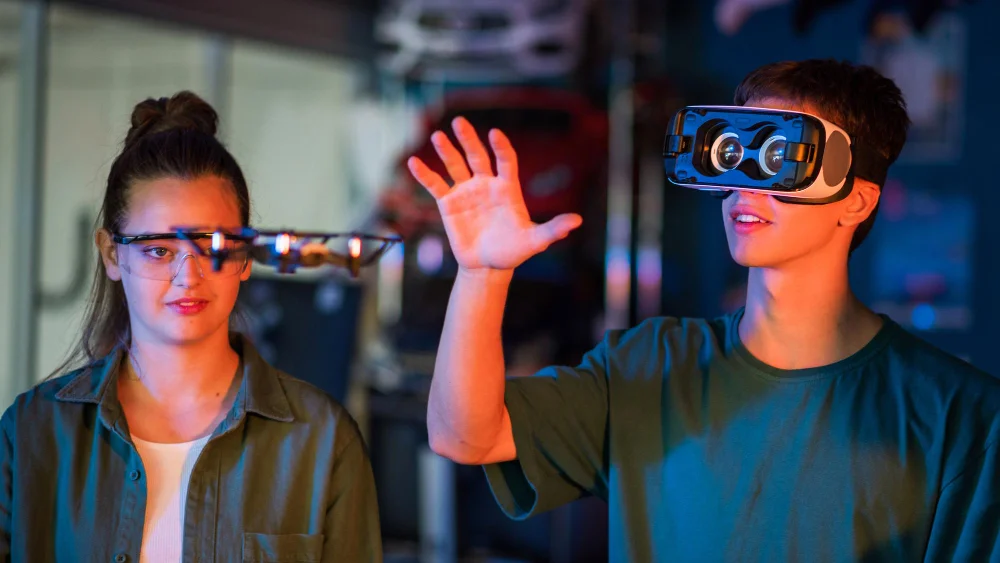The phrase Tech Giants Envision Future Beyond Smartphones has become one of the most intriguing narratives in the technology sector. For nearly two decades, smartphones have dominated our digital lives, serving as communication tools, entertainment hubs, productivity platforms, and gateways to the internet.
However, global technology leaders are beginning to prepare for what they call the post-smartphone era, a future in which our interaction with digital ecosystems no longer depends solely on handheld screens.
Instead, emerging innovations such as AR glasses, VR headsets, wearable devices, AI assistants, brain-computer interfaces, and smart homes are reshaping how humans engage with technology.
As companies like Apple, Google, Microsoft, Meta, Amazon, Samsung, and even Tesla push beyond smartphones, the tech world stands at the edge of transformation. Firstly, this article explores why tech giants are looking past smartphones. Then, it examines what technologies will define the next era. Moreover, it highlights the challenges ahead. Finally, it discusses how digital ecosystems will evolve in a world where mobile devices are no longer the centre of innovation.
Smartphones at Their Peak: Why the Next Leap Is Necessary
Despite their enormous success, smartphones are reaching a maturity stage in the innovation cycle. Hardware improvements are incremental, better cameras, faster chips, foldable screens, but the leap is no longer revolutionary. Consumers are keeping devices longer, sales growth has slowed, and the next paradigm shift feels overdue.
Smartphones remain the backbone of global connectivity, but tech companies recognize the need to diversify user experiences. Platforms such as TikTok, Instagram, and mobile gaming illustrate the limits of small-screen interaction, while rising expectations around immersion, convenience, and seamless computing push innovation toward new frontiers.
The move beyond smartphones is not about replacing them overnight but expanding digital ecosystems to create multi-device experiences that feel natural, immersive, and intelligent.
Apple: Vision Pro and the Extended Reality Ecosystem

Apple has always led shifts in consumer technology, from the iPhone revolution in 2007 to the Apple Watch’s dominance in wearables. Today, Apple is positioning itself for the post-smartphone era with its Vision Pro headset, blending augmented reality (AR) and virtual reality (VR) into what it calls “spatial computing.”
Apple’s Strategy Beyond the iPhone
Apple is not discarding the iPhone but building complementary ecosystems where users interact through multiple devices watches, glasses, AirPods, and headsets. With Apple’s tight integration of hardware, software, and services, the Vision Pro could serve as a gateway to immersive computing, especially in fields like entertainment, remote work, and education.
Challenges for Apple
The hurdles include affordability, hardware comfort, and mass adoption. Vision Pro’s initial high price limits its accessibility, but as with the iPhone, Apple’s strategy may involve premium entry followed by scaled-down versions for mainstream audiences.
Google: AR, AI, and Ambient Computing
Google envisions a world where technology blends into everyday life so seamlessly that we no longer think about “using a device” but simply live within ambient computing ecosystems.
Google’s AR Glasses and AI Push
Google Glass may have stumbled a decade ago, but Google is reviving its AR ambitions with new prototypes. Combined with Google AI tools like Gemini and its dominance in search, Google is preparing for a future where knowledge is accessed instantly through wearables and voice assistants rather than smartphones.
Beyond Smartphones: Search Without Screens
For Google, the future lies in contextual, AI-powered interactions where users ask questions verbally, receive answers visually in AR glasses, and seamlessly integrate information into their environment. This represents a paradigm shift from tapping a smartphone screen to engaging with invisible computing woven into daily routines.
Meta: Building the Metaverse

Mark Zuckerberg’s Meta has staked its future on the Metaverse, a vision of interconnected virtual spaces accessed through VR headsets, AR glasses, and digital avatars.
Meta Quest and Horizon Worlds
The Meta Quest headset series has become a leading platform in VR, offering immersive experiences for gaming, social interactions, and work. With Horizon Worlds, Meta aims to create a digital society where people collaborate, learn, and socialize beyond smartphone constraints.
Obstacles to Meta’s Ambition
The Metaverse faces skepticism around adoption, privacy, and practicality. However, Meta continues to invest billions, betting that as hardware improves and costs drop, VR and AR will move from niche to mainstream.
Microsoft: Mixed Reality and Enterprise Solutions
Microsoft’s vision extends beyond consumer devices to enterprise-driven ecosystems. The HoloLens mixed reality headset exemplifies how businesses could move past smartphones for training, design, and collaboration.
Microsoft’s Cloud Advantage
By combining Azure cloud computing, AI, and mixed reality, Microsoft aims to redefine enterprise productivity. Unlike Apple or Meta’s consumer-first approach, Microsoft targets industries like healthcare, engineering, and education, where immersive tools can outperform smartphones in efficiency and safety.
Amazon: Smart Homes and Invisible Devices
Amazon is shaping a post-smartphone future through smart homes powered by Alexa, Echo devices, and AI assistants.
Voice as the Interface of the Future
Instead of relying on touchscreens, Amazon bets on voice-first interaction. The company’s ecosystem envisions a world where appliances, lighting, security, and entertainment are all seamlessly controlled by AI. Smartphones remain part of the equation, but Amazon’s smart home strategy reduces reliance on handheld screens by embedding intelligence everywhere.
Samsung: Foldables, Wearables, and Extended Displays
Samsung continues to innovate in foldable smartphones, but it also invests heavily in wearables, AR, and next-generation displays.
Samsung’s Dual Strategy
Unlike Apple, which moves users beyond smartphones, Samsung combines evolutionary smartphone innovation (foldables) with revolutionary exploration (AR/VR and wearables). This dual approach ensures relevance in the smartphone market while also preparing for the inevitable shift toward post-smartphone ecosystems.
Tesla and Neural Interfaces: Human-Tech Integration
While not traditionally seen as a consumer electronics leader, Tesla and Elon Musk’s ventures, including Neuralink, are critical to the future beyond smartphones.
Brain-Computer Interfaces
Neuralink aims to develop brain-computer interfaces (BCIs) that allow humans to interact with digital systems directly through thought.
While still experimental, such technology represents the ultimate step in moving beyond screens entirely, offering a glimpse into a world where smartphones become obsolete.
The Role of Artificial Intelligence in a Post-Smartphone World
AI serves as the glue connecting all these emerging technologies. From Apple’s Siri and Google Assistant to Amazon’s Alexa and Microsoft’s Copilot, intelligent systems enable more natural, intuitive, and proactive interactions than smartphones can offer alone.
AI-Powered Future
AI allows for predictive assistance, personalized recommendations, real-time translation, and advanced problem-solving, all integrated into wearables, AR glasses, and even neural devices. In the post-smartphone era, AI is not just a feature; it becomes the foundation of the digital ecosystem.
Opportunities and Challenges in the Post-Smartphone Era
Opportunities
- Immersive Experiences: AR/VR offers deeper engagement than smartphones.
- Seamless Ecosystems: Devices working together create fluid interactions.
- Accessibility: Voice and AI open technology to those unable to use screens.
Challenges
- Adoption Barriers: Cost, complexity, and cultural acceptance slow transitions.
- Privacy and Ethics: AI and AR raise surveillance and data misuse concerns.
- Health Risks: Extended VR/AR use may impact physical and mental well-being.
Case Studies and Expert Predictions
- Apple Vision Pro: Analysts predict adoption will grow as costs decline, mirroring the iPhone’s trajectory.
- Google’s AI Ecosystem: Experts foresee ambient computing replacing smartphones in knowledge access.
- Meta’s Metaverse: While controversial, Goldman Sachs projects the Metaverse economy could exceed $8 trillion by 2030.
- Tesla’s Neuralink: Experts suggest BCIs may first revolutionize healthcare before entering mainstream consumer use.
Smartphones vs. Future Tech Ecosystems
Smartphones: Portable, familiar, reliable, and central to daily life.
Future Tech: Immersive, multi-device, AI-driven, and integrated into environments.
Rather than a simple replacement, the transition looks like a layered ecosystem where smartphones gradually play a supporting role instead of being the centre of innovation.
Ethical and Societal Considerations
As tech giants envision life beyond smartphones, ethical debates intensify. Concerns include:
- Surveillance capitalism in AR environments.
- Bias in AI shaping user experiences.
- Digital dependency affecting human interaction.
Responsible innovation must balance progress with trust, ensuring technologies enhance lives without compromising privacy or autonomy.
Future Trends: What Comes After Smartphones?
- Mainstream AR Glasses by Apple, Google, and Samsung.
- Expanded Smart Homes where voice and AI dominate.
- Workplace Mixed Reality led by Microsoft.
- Metaverse Platforms for social and business interactions.
- Brain-Computer Interfaces making early breakthroughs in healthcare.
Conclusion
The Tech Giants Envision Future Beyond Smartphones narrative highlights a profound shift in digital innovation. While smartphones remain central today, companies like Apple, Google, Microsoft, Meta, Amazon, Samsung, and Tesla are already laying foundations for a post-smartphone era defined by AR, VR, AI, wearables, and even neural technology.
This transformation will not replace smartphones overnight but gradually reshape digital ecosystems, weaving technology into every corner of human life. As opportunities grow and challenges unfold, one truth is clear: the future of technology is immersive, intelligent, and far bigger than the smartphone in your pocket.

